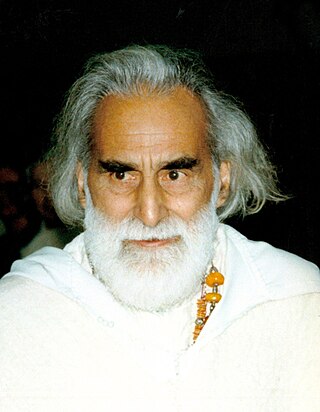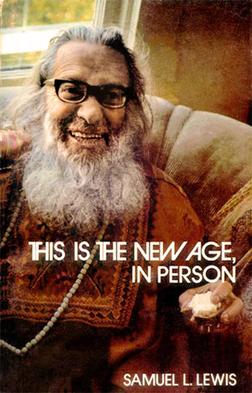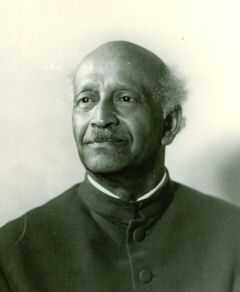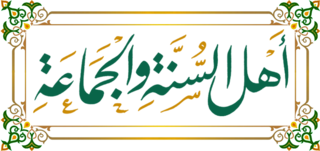
Inayat Khan Rehmat Khan was an Indian professor of musicology, singer, exponent of the saraswati vina, poet, philosopher, and pioneer of the transmission of Sufism to the West. At the urging of his students, and on the basis of his ancestral Sufi tradition and four-fold training and authorization at the hands of Sayyid Abu Hashim Madani of Hyderabad, he established an order of Sufism in London in 1914. By the time of his death in 1927, centers had been established throughout Europe and North America, and multiple volumes of his teachings had been published.

Vilayat Inayat Khan was a teacher of meditation and of the traditions of the East Indian Chishti Sufi order of Sufism. His teaching derived from the tradition of his father, Inayat Khan, founder of The Sufi Order in the West, in a form tailored to the needs of Western seekers. One of his sisters was Noor Inayat Khan GC MBE. He taught in the tradition of Universal Sufism. His parents met at the New York City ashram of American yogi, Pierre Bernard, half-brother of his mother Pirani Ameena Begum.

The Chishtī Order is a tariqa, an order or school within the mystic Sufi tradition of Sunni Islam. The Chishti Order is known for its emphasis on love, tolerance, and openness. It began with Abu Ishaq Shami in Chisht, circa 930 AD in a small town near Herat, a strategic city in then Eastern Persia, which later became independent and then part of Afghanistan.

The Dances of Universal Peace (DUP) are a spiritual practice that employs singing and dancing the sacred phrases of the world's religions. Their intention is to raise consciousness and promote peace between diverse religions according to one stated goal. The DUP are of North American Sufic origin. They combine chants from many world faiths with dancing, whirling, and a variety of movement with singing.

Samuel L. Lewis also known as Murshid Samuel Lewis and Sufi Ahmed Murad Chisti was an American mystic and horticultural scientist who founded what became the Sufi Ruhaniat International, a branch of the Chishtia Sufi lineage. After a lifetime of spiritual study with teachers East and West, primarily Inayat Khan and Nyogen Senzaki, Lewis was recognized simultaneously as a Zen master and Sufi murshid by Eastern representatives of the two traditions. He also co-founded the Christian mystical order called the Holy Order of Mans. His early interest in international seed exchange and organic agriculture also established him as one of the pioneers of green spirituality. His most enduring legacy may be the creation of the Dances of Universal Peace, an early interspiritual practice that has spread around the world in the 50 years since his death.

Zia Inayat-Khan is a scholar and teacher of Sufism in the lineage of his grandfather, Inayat Khan. He is president of the Inayati Order and founder of Suluk Academy, a school of contemplative study with branches in the United States and Europe.

Khawajah Syed Qutbuddin Maudood Chishti (RA) (Urdu: مودود چشتی) (also known as Qutubuddin, Shams Sufiyaan and Chiraag Chishtiyaan) was an early day Sufi Saint, a successor to his father and master Abu Yusuf Bin Saamaan, twelfth link in the Sufi silsilah of Chishti Order, and the Master of Shareef Zandani. He was born around 430 Hijri in the city of Chisht. He initially received education from his father. He memorized the Qur'an by age 7 and completed his education when he was 16. His work includes two books, Minhaaj ul Arifeen and Khulaasat ul Shariah. He died in the month of Rajab at the age of 97 in 533 AH (March 1139 CE). He was buried at Chisht like many of the early Chishtiyya.

Yakzan Hugo Valdez was a Sheikh of the Sufi Order International initiated by Pir Vilayat Inayat Khan and of the Mevlevi Order initiated by Suleyman Hayati Dede, Sheikh of Konya. Yakzan was additionally a celebrated master of the Dances of Universal Peace as originated by Samuel L. Lewis and an acknowledged peer of the Sheikhs of the Sufi Islamia Ruhaniat Society. Yakzan was a long-term resident of Honolulu, Hawaii. He established Sufi communities in Hawaii, Chile, and Spain.

Shaikh-ul-Mashaik Pyaromir Maheboob Khan (1887–1948) was born in Baroda, India. An Indian classical musician and younger brother of Inayat Khan, he became the representative of the International Sufi Movement on the latter's death in 1927.

Pir-o-Murshid Mohammed Ali Khan (1881–1958) was the leader of the International Sufi Movement from 1948 until his death. He was a second cousin of Inayat Khan, the grandson of Inayat's grandfather and therefore according to Indian custom considered a brother.

Musharaff Moulamia Khan was born in Baroda (India) on 6 September 1895 and died in The Hague (Netherlands) on 30 November 1967. Не was the youngest brother of Inayat Khan, and shared his delight in music. While in his teens he had just come to Calcutta to study and be under the influence of his brother when Inayat was called away to America, and Musharaff was left alone. Within a year, however, he also journeyed to the west, where he joined Inayat and became one of 'The Royal Musicians of Hindustan.'

The Inayati Order (Inayatiyya), is an international organization dedicated to spreading the Sufi teachings of Inayat Khan, a musician and mystic who first introduced Sufism to the modern Western world in 1910. The Inayati Order operates internationally through a network of centers, and offers a number of programs and activities. It is led by Zia Inayat Khan, grandson of Inayat Khan.
The Sufi Ruhaniat International (SRI) is a stream of Universal Sufism and draws inspiration from traditions of Sufism within and beyond historic Islam. SRI is an initiatic order within the lineage of Inayat Khan (Inayati-Chishtiyya). Sufi Ahmed Murad Chisti, a disciple of Inayat Khan, formally founded the order in 1970. There are centers throughout the United States, Belgium, Canada, the Netherlands and the United Kingdom.
Syed Abdullah shah, popularly known as Hazrat Hajji Bahadar Kohati, Sufi saint of Kohat, was born on July 31, 1581, AD, in Agra (India) during the reign of Mughal Emperor Shah Jahan.

Shabda Kahn serves as Pir of the Sufi Ruhaniat International, a branch within the spiritual lineage of Pir-o-Murshid Hazrat Inayat Khan. He is also a teacher and performer of Hindustani classical vocal music, Raga, in the Kirana Gharana style, serving as director of the Chisti Sabri School of Music, within the lineage of his teacher Pandit Pran Nath, at whose direction this school was formed and placed in Shabda Kahn's care.

Pir Syed Jamaat Ali Shah was a Pakistani author, Islamic scholar and Sufi saint of the Naqshbandi Order. He presided over the All India Sunni Conference and led the Movement for Shaheed Ganj Mosque. He was a contemporary of Ahmed Raza Khan Barelvi, the founder of Barelvi movement.

Syed Nadir Ali Shah, popularly known as Murshid Nadir Ali Shah, was a Sufi saint of the Qalandariyya sufi order of Islam, a Muslim preacher, ascetic, mystic, philanthropist and humanitarian. Born in Gandaf in the north-west of the Indian subcontinent, he eventually settled in Sehwan Sharif, Sindh. He was a spiritual descendant of the well-regarded Sufi saint Lal Shahbaz Qalandar and the custodian of the revered Sufi Khanqah, Kafi Sakhi Sarwar located in Sehwan Sharif. Nadir Ali Shah's legacy primarily revolves around his distinction as one of the most remarkable figures among the saints of the Qalandariyya Sufi order. He is renowned for his pursuits in Islamic preaching, mysticism, and asceticism. Beyond his spiritual contributions, he is recognized for his substantial efforts in advancing human welfare and uplifting the underprivileged, in line with the teachings of the Qalandariyya Sufi order of Islam. Notably, he also served as the custodian of the shrine of the Sufi saint Abdullah Shah Ghazi in Karachi.
Abdul Hai Arifi was a Pakistani Muslim scholar and a Sufi mentor of the Chishti order. He was a disciple of Ashraf Ali Thanwi. He authored books including Uswah Rasool-e-Akram and Death and Inheritance. He served as the president of Darul Uloom Karachi for ten years.

Sufism Reoriented Sanctuary is a universal spiritual retreat located in Walnut Creek, California, United States. The sanctum sanctorum is located at 11 White Horse Court. The Sanctuary was founded and rechristened by spiritual master Meher Baba in 1952.
















